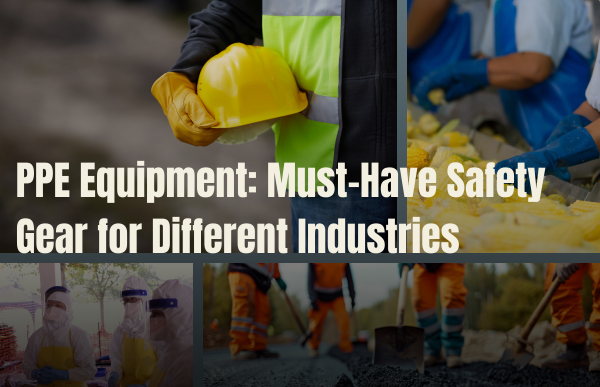
PPE Right for Different Industries
Personal Protective Equipment (PPE) is essential for ensuring workplace safety across various industries. The right PPE minimizes the risk of injury, illness, and exposure to hazardous conditions. This article will break down the must-have PPE for four major industries: healthcare, construction, chemical handling, and food processing. Each sector has unique risks, and selecting the appropriate safety gear is crucial for maintaining compliance and worker well-being.
PPE for Healthcare Workers
1. Face and Eye Protection
- Face Masks & Respirators: Protect against airborne pathogens (e.g., N95 masks for viruses, surgical masks for general protection).
- Face Shields: Used in conjunction with masks to prevent droplet exposure.
- Goggles: Essential in environments with splashes of bodily fluids or chemicals.
2. Hand Protection
- Disposable Gloves: Nitrile, latex, or vinyl gloves prevent cross-contamination.
- Sterile Surgical Gloves: Used for invasive procedures requiring aseptic techniques.
3. Body Protection
- Gowns & Coveralls: Prevent contamination in high-risk areas such as ICUs and laboratories.
- Aprons: Provide an additional barrier against bloodborne pathogens and chemicals.
4. Footwear
- Shoe Covers: Minimize contamination in sterile environments.
- Non-Slip Medical Shoes: Reduce the risk of falls in healthcare settings.
5. Hearing Protection
- Earplugs or Earmuffs: Necessary in high-noise environments such as MRI rooms.
Key Risks Addressed:
- Pathogen exposure (bacteria, viruses)
- Cross-contamination
- Chemical and fluid exposure
PPE for Construction Workers
1. Head Protection

- Hard Hats: Protect against falling objects and head injuries.
- Bump Caps: Used in areas with low overhead hazards.
2. Eye and Face Protection
- Safety Glasses: Protect from dust, debris, and flying particles.
- Full-Face Shields: Used during cutting, grinding, or welding.
3. Respiratory Protection
- Dust Masks: Protect against airborne particles like silica and asbestos.
- Half-Face & Full-Face Respirators: Used in environments with toxic fumes or vapors.
4. Hand and Arm Protection
- Impact-Resistant Gloves: Protect against crush injuries.
- Cut-Resistant Gloves: Prevent lacerations when handling sharp materials.
5. Foot Protection
- Steel-Toe Boots: Shield feet from falling objects.
- Slip-Resistant Boots: Prevent falls on wet or uneven surfaces.
6. High-Visibility Clothing
- Reflective Vests & Jackets: Improve visibility in low-light or high-traffic areas.
Key Risks Addressed:
- Impact and falling object injuries
- Inhalation of harmful dust and chemicals
- Electrical hazards
PPE for Chemical Handling
1. Eye and Face Protection
- Chemical Splash Goggles: Prevent chemical exposure to the eyes.
- Face Shields: Used alongside goggles for additional splash protection.
2. Respiratory Protection
- Gas Masks & Full-Face Respirators: Provide protection against toxic gases and vapors.
- Cartridge Respirators: Filter out specific chemical fumes.
3. Hand Protection
- Chemical-Resistant Gloves: Made of materials like nitrile, neoprene, or butyl rubber.
4. Body Protection
- Chemical-Resistant Suits: Prevent direct skin exposure to hazardous substances.
- Aprons and Lab Coats: Provide added protection against spills.
5. Footwear
- Chemical-Resistant Boots: Shield feet from hazardous liquid spills.
6. Hearing Protection
- Earplugs or Earmuffs: Used in noisy environments with machinery or ventilation systems.
Key Risks Addressed:
- Chemical burns and irritation
- Inhalation of toxic fumes
- Skin and eye exposure to corrosive substances
PPE for Food Processing Workers
1. Head Protection
- Hairnets and Beard Covers: Prevent contamination of food products.
- Bump Caps: Protect from minor head injuries.
2. Eye and Face Protection
- Safety Glasses: Protect against splashes from cleaning agents.
- Face Shields: Used in environments with high exposure to liquids or chemicals.
3. Respiratory Protection
- Dust Masks: Used in environments with airborne flour or other fine particles.
4. Hand Protection
- Cut-Resistant Gloves: Prevent knife-related injuries.
- Disposable Gloves: Maintain hygiene and prevent cross-contamination.
5. Body Protection

- Aprons Smocks: Shield against food spills and contaminants.
- Full-Body Suits: Used in areas requiring sterile conditions.
6. Footwear
- Non-Slip Shoes: Prevent falls on wet or greasy floors.
- Waterproof Boots: Used in environments requiring regular cleaning with liquids.
Key Risks Addressed:
- Cross-contamination
- Knife and machinery injuries
- Slip and fall hazard
The right Personal Protective Equipment (PPE) is essential for worker safety across industries. Healthcare professionals require pathogen protection, construction workers need impact-resistant gear, chemical handlers must use chemical-proof materials, and food processing employees prioritize hygiene and slip prevention. Employers must ensure compliance with safety standards and provide PPE tailored to the risks of their specific work environments. Proper use and maintenance of PPE can significantly reduce workplace injuries and promote a safer working environment.



